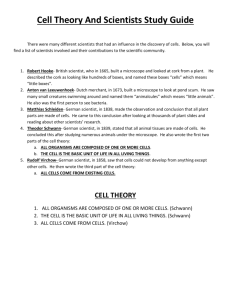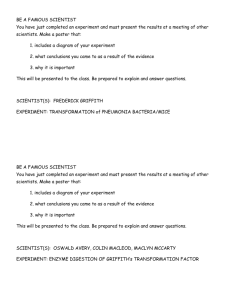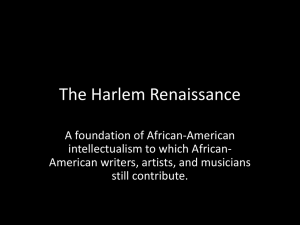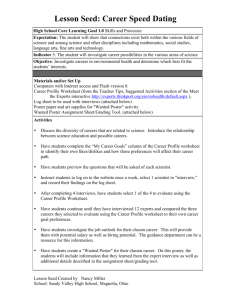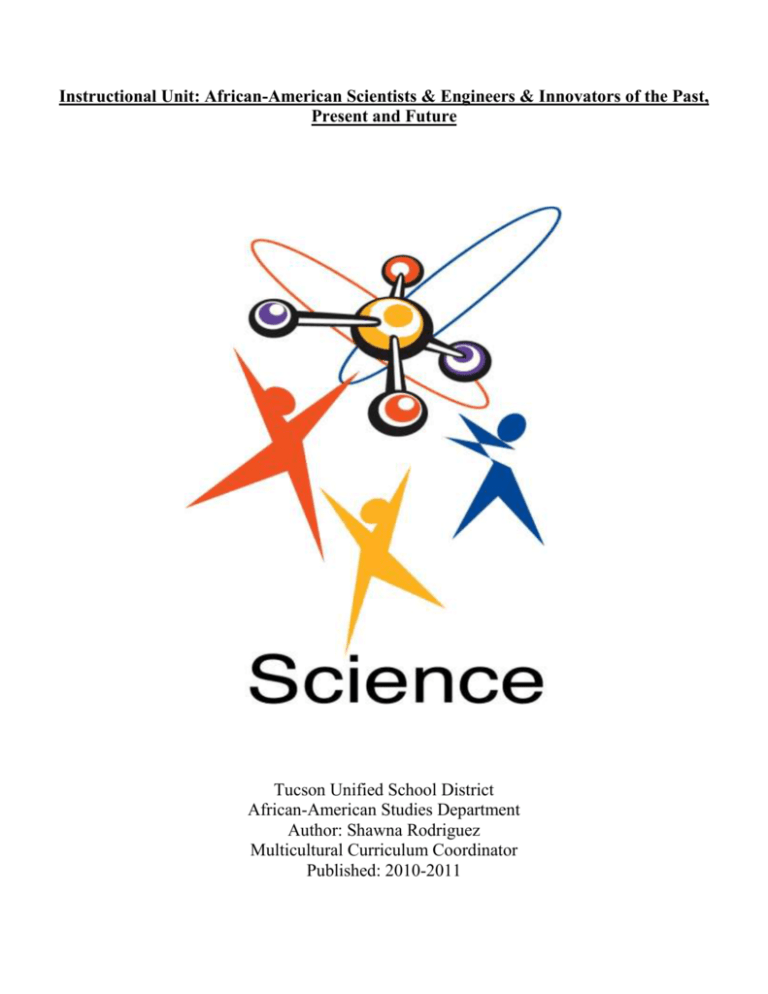
Instructional Unit: African-American Scientists & Engineers & Innovators of the Past,
Present and Future
Tucson Unified School District
African-American Studies Department
Author: Shawna Rodriguez
Multicultural Curriculum Coordinator
Published: 2010-2011
“I Think; Therefore, I Am”~ Rene Descartes:
Celebrating African-American Scientists, Inventors and Innovators
This unit will focus on African-Americans and their accomplishments in the realm of science, engineering, and
medicine. Using a variety of instructional methods students will study various individuals and their personal
story of success, the scientific and technological sophistication of these individuals and the impact of the
accomplishment(s) on today’s society as a whole. The following course outcomes are supported by core subject
areas Biology, Chemistry, Math, and Science.
(All curriculum/lessons provided are in alignment with Arizona State Standards).
Students will be able to: (S.W.B.A.T.): COURSE OUTCOMES
Analyze concepts and applications of science, biology, chemistry
Understand accomplishments of African-Americans and how they arrived at them
Describe the accomplishments/contributions of African-Americans
Understand the barriers and inequities African-Americans faced in their quest for recognition and credit
for their work
Explain how racism existed within Euro-American culture vs. African culture
Define terms such as patent, innovation, intellectual property, agriculture, pioneer, inoculation
Understand the impact of these contributions in today’s society and how these problem-solvers
positively impacted science, medicine, and technology
Who Am I?
African-American Scientists, Engineers, and Innovators of the Past Present and Future
(Point Value: “E” for Effort)
Directions: Please fill in the name of the person from the list of names below. Place this name under the
contribution, invention, or accomplishment he/she made.
George Washington Carver
Madame C. J. Walker
Benjamin Banneker
Lonnie Johnson
Andrew Beard
Dr. Daniel Williams
Marie Brown
Patricia Bath
Charles Turner
Garrett Morgan
Lewis Latimer
Dr. Charles R. Drew
1. I am an authority on insects and the 1st to prove they could hear
Who Am I? ____________________________
2. I am best known for publishing an almanac based on my astronomical calculations.
Who Am I? ____________________________
3. I not only founded the Provident Hospital in Chicago in 1891, but also performed the first successful
open heart surgery in 1893.
Who Am I? _____________________________
4. I conducted research in blood plasma and set up the first blood bank
Who Am I? _____________________________
5. I invented the carbon filaments for the Maxim electric incandescent light bulbs and was the only black
member of Thomas Edison’s engineering division
Who Am I? _____________________________
6.
I am the 1st African-American female doctor to patent a medical invention known as the Cataract
Laserphaco Probe (a laser device making eye surgery more accurate) Who Am I?
____________________________
7. In 1881 I patented my first invention, a plow, and sold the patent rights for $4,000. Later in 1897, I
invented the Jenny Coupler hooking railroad cars together
Who Am I? ______________________________
8. I invented a gas mask to recue 32 men trapped during an explosion in an underground tunnel and would
later invent a t-shaped traffic signal we now know as traffic lights Who Am I?
__________________________
9. I have revolutionized the hair care and cosmetics industry for African-American women
Who Am I? ___________________________
10. I invented the first home security system on Dec. 2nd, 1969. The system used television surveillance
Who Am I? _________________________
11. I am an agricultural chemist, who discovered 300 hundred uses for peanuts including peanut butter
Who Am I? ___________________________
12. In 1988, I invented the “Super Soaker” formerly known as the “Power Drencher”
Who Am I? ______________________________
Lesson Plan: - African American Scientists
Teacher: _______________________
Subject: SCIENCE Grades 3-5, 6-8, 9-12
Date: ________________
Applied Standard(s): SC03-S2C1 (change according to grade
level)
Time: Three to four class sessions
Concept/Objective(s): History of Science as a human endeavor
PO 1. Identify how diverse people and/or cultures, past and present, have made important contributions to
scientific innovations
Purpose (Real World Connection): The importance of the human aspects of science and the role that scientists
play in the development of various cultures with an emphasis on African American scientists.
Activities (Input by teacher, guided practice, summary):
Anticipatory set may include discussion of contributions to the field of science and the profound
impact on our society
Teacher will explain how African American Scientists may have had to face different barriers when
making the effort to make their contributions to the field
Teacher will explain the project/assignment to students
1) Students will then use Internet and/or library resources to research the accomplishments/contributions of
an African American Scientist, Engineer, or Inventor
2) Students will be encouraged to visit various websites/books before selecting his/her individual
3) Students will organize and begin filling out the worksheet in regards to the selected individual (See
Below)
4) Students will transfer this information onto a poster board for presentation or for high schoolers,
students may want to present into a Power-Point (include a picture of the person, if possible a drawing
or picture of the invention and highlights of the accomplishments)
5) Students will present information to the class and teacher
6) Teacher may or may not create a rubric for grading
Measurement of Learning:
Student presentation will be used as assessment
Thoroughness, depth, creativity, and participation will demonstrate mastery
Does this material cover new/previously-covered material?
Text/Supplemental Materials:
*Computers
*Poster Board
*Scissors
*Markers
*Glue
African American Scientists
Lesson Title: African Americans in Science
Name:____________________________
For this assignment, you will prepare a poster on an African American scientist. In order to complete your poster, you will
need to research your subject. Look for personal and historical information about the place and time this person lived and
worked. Gather facts about the field of science this person succeeded in. Keep in mind that you will use this information to
present your scientist, inventor, or engineer to the class. Answer the questions below and turn this student sheet in to your
teacher along with your poster or Power Point.
Who is the scientist you have selected?
Why did you select this person?
What did this person contribute to the world of science?
What time period in history did this person live? How did the time and place affect his/her accomplishments?
Did this person have to overcome any obstacles in his or her career? Did any of these obstacles have to do with race?
List any websites that you have used for your poster research:
List any books or articles that you have used for your poster research:
***All rights reserved. Science NetLinks Student Sheets may be reproduced for educational purposes.
Lesson Plan: - African American Scientists
Teacher: _______________________
Date: ________________
Subject: SCIENCE Grades 5th, 6-8, 9-12
Applied Standard(s): SC03-S2C1 (change according to grade
level)
Time: Three to four class sessions
Learning context:
This is a research activity that will be used for a research based writing project the 5th grade students will do
with an African-American Studies class at the High School. Each student will visit a variety of sites, and use
classroom and library resources, to gather information about an African-American Inventor and/or Scientist.
They will use graphic organizers in the note taking process, create storyboards, and produce a short slide show
in Power Point to share the information they have learned. The High School students will interview the 5th
graders as they take on the role of the person they have researched. The High School students will then write a
news article based on the interview.
Learning Standards Referenced:
Standard 1: Students will read, write, listen, and speak for information and understanding.
Social Studies Standard 1: History of the United States and New York Students will use a
variety of intellectual skills to demonstrate their understanding of major ideas, eras, themes,
developments, and turning points in the history of the United States and New York.
Standard 2 – Information Systems:
Students will access, generate, process, and transfer information using appropriate technologies
Performance Indicators:
1. Listening and reading to acquire information and understanding involves collecting data,
facts, and ideas; discovering relationships, concepts, and generalizations; and using knowledge
from oral, written, and electronic sources.
Students:
gather and interpret information from children’s reference books, magazines, textbooks, electronic
bulletin boards, audio and media presentations, oral interviews, and from such forms as charts, graphs,
maps, and diagrams
select information appropriate to the purpose of their investigation and relate ideas from one text to
another
select and use strategies they have been taught for note-taking, organizing, and categorizing information
ask specific questions to clarify and extend meaning
make appropriate and effective use of strategies to construct meaning from print, such as prior
knowledge about a subject, structural and context clues, and an understanding of letter-sound
relationships to decode difficult words support inferences about information and ideas with reference to
text features, such as vocabulary and organizational patterns.
Social Studies
1. The study of New York State and United States history requires an analysis of the
development of American culture, its diversity and multicultural context, and the ways people
are unified by many values, practices, and traditions.
Students:
know the roots of American culture, its development from many different traditions, and the ways many
people from a variety of groups and backgrounds played a role in creating it
1. Information technology is used to retrieve, process, and communicate information and as a
tool to enhance learning.
Students:
use a variety of equipment and software packages to enter, process, display, and communicate
information in different forms using text, tables, pictures, and sound.
telecommunicate a message to a distant location with teacher help.
access needed information from printed media, electronic data bases, and community resources.
Assessments: Student slide shows will be graded using the attached rubric.
Student Outcomes (Exemplars):
Students will navigate Internet sites successfully, locate and take notes on appropriate information for
the assignment
Students will use note taking skills to organize information gathered about an historic figure
Students will create a storyboard to effectively present information gathered
Students will use Power Point to create a slide show using criteria on rubric
Students will be able to articulate answers to questions from High School buddies during interview
process via Video Conferencing equipment
Procedure:
Students are assigned an African-American scientist or inventor to research
Students use the Internet and print material to gather information relating to questions posed, as well as
anything else that will make the interview process interesting and informative for the high school
student doing the interview.
After the teacher has ascertained that the student has gathered sufficient information, the student plans
the slide show by creating a storyboard.
When the storyboard is approved, the student creates the slide show.
At the conclusion of the research, High School students interview the 5th graders using Video
Conferencing equipment and use the information they acquire during the interview to write a news
article about the inventor or scientist.
Instructional Modifications:
Teachers can have more able students help less able if necessary. Students could be paired up for the
research and interview.
Time Required:
Student research should take about 4 sessions of 45 minutes.
Storyboard and slide show could take about 2 or 3 sessions of 45 minutes depending on the skill level
of the children.
Interviews may take several days to complete depending on how it’s done. We have one
videoconference station so it will take several class periods.
Resources (materials):
Computers with Internet access and Power Point
Graphic organizers, notebooks, clipboards, library books, encyclopedias
Lesson Provided by: Gwynneth Delong
Lesson Plans: Websites and Resources
Some of the following resources have lesson plans ready to go!
Topic:
Era:
Source:
Grade Level:
Science/Engineering
All
https://webfiles.uci.edu/mcbrown/display/faces.html/
All
Science/Engineering/Inventors
All
http://www.sciencenetlinks.com/bhm/index.php
3-12
Academic Achievements
All
http://www.achievement.org/autodoc/page/car1bio-1
5-12
Coloring pages
N/A
http://printables.familyeducation.com/tv/printables/0673586456_17.pdf
k-5
Various Lessons
All
http://www.nea.org/tools/black-history-month.htm#Print
All
Inventors
All
http://www.blackinventor.com/pages/janmatzeliger.html
7-12
National Society of Black
Engineers
N/A
http://www.nsbe.org/default.aspx
4-12
Understanding Intellectual
Property
N/A
Famous Black Inventors
All
http://inventors.about.com/od/blackinventors/Famous_Black_Inventors .htm
4-12
PBS Short Films- “Footprints
Through Time”
HBO Film/DVD
N/A
http://www.pbs.org/wgbh/amex/partners/legacy/l_colleagues_pop.ht
ml
6-12
N/A
“Something the Lord Made” Rated:
8-12
http://inventors.about.com/od/patenttrademarkcopyright/a/Intellectual_Pr.htm
& “Gifted Hands: The Ben Carson Story” Not rated
Young Futurists: 25 and
under
George Washington Carver
Curr
ent
http://www.theroot.com/views/2011/young-futurists
4-12
http://teacherlink.ed.usu.edu/tlresources/units/Byrnesfamous/carver.html
4-8


